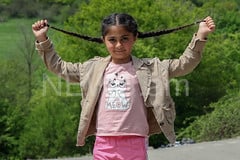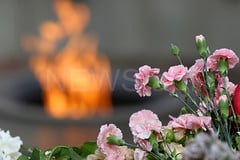
Lost in the Gegharkunik province mountains, the village of Kalavan is a true paradise for fans of extreme recreation, and ascetic lifestyle, and those who simply seek solitude away from the bustle of the city .
In recent years, Kalavan has been attracting more and more tourists from Armenia and abroad, thanks to its remoteness from civilization, its inaccessibility, its picturesque mountain scenery, and, most importantly, its hospitable, friendly, and open people (PHOTOS).
To get to Kalavan, located at an altitude of 1,600 meters above sea level, the traveler should overcome a 7-kilometer winding mountain road leading from the main highway to the village through a dense forest. And it is possible to pass this way only in Soviet cars or off-road vehicles. We managed to pass the serpentine in about 40 minutes. Our driver told us that the road has long forgotten what repair and backfilling are: the problems of a remote mountain village are far from the focus of attention of the authorities and specialized government agencies.
But despite the difficult socio-economic situation, the deplorable state of infrastructure, lack of roads, stores, and basic living conditions, Kalavan is gradually reviving, turning its problems into competitive advantages, and people here are beginning to forget what despair and hopelessness are.
Robert Ghukasyan, a 38-year-old local enthusiast, shared with us the formula for success in this small village.
Today only 130 people live in the village, while in Soviet times the population reached about 300. Robert is happy that the local school is no longer empty. There are about 15 students in it. In 2013, the school had only 9 students.
In 2013, Robert, trained as an archaeologist and archaeozoologist and having participated in numerous scientific projects and expeditions around the world, decided to establish the Time Land Science and Learning Foundation in Kalavan to professionally deal with community development with a focus on tourism and environmental protection.
"I tried to do something for my village so I wouldn't blame myself later for missing an opportunity. First of all, I focused on archaeological tourism with scientific and educational elements, since Kalavan is a place of an ancient settlement where excavations are actively conducted," says Robert.
Within a year of the launch of the project, tourists from Armenia and around the world started coming to Kalavan. Now the village annually receives over 2500 people while the demand is 10 thousand. Kalavan is interesting first of all for archaeologists, scientists, and students of many international educational institutions who want to be in the image of an ancient man, live in a hut, make a fire, obtain food by primeval method, etc.
Robert then developed a ten-year community development program, the concept of which is simple: to show life in the village unvarnished and artificial, to put people in a positive mood, and to understand what potential our village, its area, and people have.
Many organizations were interested in Robert's community development program, including the Armenian travel agency Gardman Tour, which specialized in adventure and extreme tourism, as well as the international network of tour operators Adventure Travel Trade Association, who invited Robert to speak at an international tourism conference as one of the three keynote speakers. Robert has since authored some 50 articles for various international media, including Israel's National Geographic Magazine.
Today there are about 10 guest houses in Kalavan, all of which have solar water heaters. In general, solar energy should become a priority in Kalavan - solar panels and water heaters will be installed, not only in guest houses but also in other houses of the village.
In the framework of USAID/PRP with the support of UNDP, a scientific and educational tourist center is being constructed in Kalavan with an adjacent tent zone where guests of Kalavan will receive hotel, medical, informational, and catering services. There will also be a Time Land Foundation office, conference hall, museum, library, and laboratory.
Kalavan is attractive not only as a tourist center. Many residents of the capital and foreigners want to buy a house and set up a farm here. But locals are no longer willing to sell their homes, even though real estate in Karavan, including land, has become much more expensive. Before the house in the village cost $400 on average, but now the prices have reached $15 thousand on average. The rise in real estate prices shows that Kalavan is growing economically.
Nevertheless, the condition of the road leading to the village remains an urgent problem in Kalavan. Robert says that the asphalt surface here is not suitable, as it requires constant maintenance and renewal, it is enough to improve the dirt road, to fill at least the potholes. The residents of Kalavan will have to solve this problem on their own unless the government allocates at least some funding by the end of the year. The previous promises of the authorities, as Robert says, have still not been fulfilled.
In Kalavan, we met Armenia's Honorary Consul in Las Vegas, Atrushan (Andy) Armenian, who came here on a three-day visit after learning from social media about the phenomenon of the Armenian mountain village. "Robert and his friends encouraged people to do business without fear, thanks to which the village is no longer empty today. Everything I have seen in Kalavan in a short period has become dear to me. I love extreme recreation and intend to come here in the summer season for hiking. I would also like to buy a house here, but unfortunately, they don't sell them anymore," Andy said.
Vahe Boyajian, a researcher at the Institute of Archaeology, started building his own house in Kalavan two years ago and spends half the year in the village.
"I am attracted here not only by nature and archaeological excavations but above all by the people of Kalavan, who have strong ties with their land," Boyajian told us.
Five families in Kalavan started organic farming a year ago. Artur Amirkhanyan founded a beekeeping farm specializing in the production of organic honey. He sells his products not only in Yerevan but also to visitors during the tourist season.
Hovik Ghukasyan, a chess teacher at the local school, says his guest house has hosted around 300 guests this year. These were mostly archaeologists from Slovakia, Poland, Germany, Latin America, Japan, and Thailand. At the moment, accommodation in Kalavan guesthouse costs AMD 6 thousand per day, but Hovik is sure that shortly prices in Kalavan hostels will significantly rise.
Klavan's example may become contagious in other villages and underdeveloped regions of Armenia. Robert intends to share his concept of community development with neighboring villages, including border villages.
The residents of Kalavan believe that despite social difficulties and the lack of infrastructure, the quality of life can be improved if you believe in yourself, and in your capabilities, unite around one idea and promote it through joint efforts. From now on, Kalavan residents connect their dreams and hopes with the development of the mountain village, which became their home "on the border of the sky" for them years ago.






















